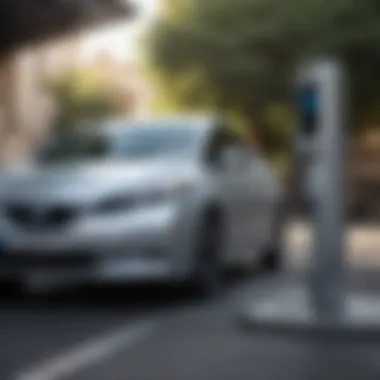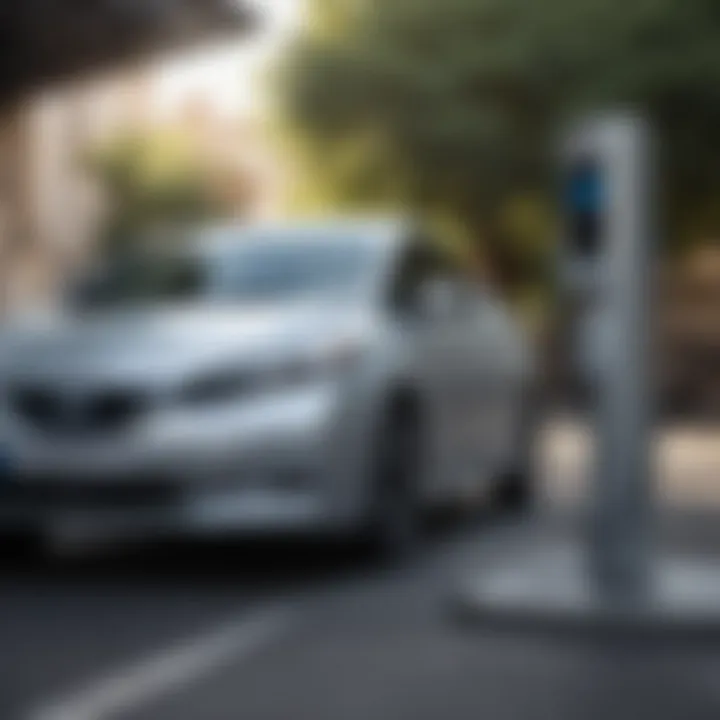Exploring the Nissan Leaf's Electric Range Performance


Intro
The Nissan Leaf has become a mainstay in the electric vehicle landscape, but how does its mile range stack up against the competition? This discussion explores the intricacies of the Leaf’s performance, particularly its range capabilities, which can significantly impact the purchasing decision for many automotive enthusiasts and eco-conscious buyers.
In examining the Leaf's mile range, several factors come into play. These range from its battery technology to real-world driving conditions. Each element plays a crucial role in understanding not just the Leaf itself, but the future of electric vehicles as a whole.
This article will lay out the essential components that shape the Leaf's mile range and provide a thorough analysis, allowing you to make an informed choice, whether you're considering a purchase or merely curious about electrification in the automotive industry.
Preamble to the Nissan Leaf
The Nissan Leaf stands out as a quintessential emblem of electric vehicles, already making waves in the automotive world since its debut in 2010. As curiosity for eco-friendly commuting grows among buyers, understanding the Nissan Leaf becomes pivotal. Not only does this model represent a shift in how we view transportation, but it also embodies significant advancements in technology, battery life, and practical usability.
This article serves as a guide for prospective EV owners and enthusiasts alike, addressing how the Leaf's unique attributes influence its mile range. Understanding the factors leading to the Leaf’s driving capabilities helps drivers make informed choices, shaping their daily commuting experience while promoting sustainability. With increasing gasoline prices and growing environmental concerns, knowing the ins and outs of the Leaf can open new pathways toward green travel.
History and Evolution
The Leaf's journey began with Nissan's aim to revolutionize the way we think about electric vehicles. The concept was rooted in providing a sustainable alternative to traditional gas-powered cars. Since its initial launch, the Leaf has undergone multiple enhancements—incremental improvements from battery capacity to technology integrations have not gone unnoticed.
In the early years, the Leaf had a modest range of about 73 miles in ideal conditions. With demand rising, Nissan rolled out several upgrades, releasing models capable of exceeding 200 miles on a single charge. Such evolution is not merely technical; it's a corporate commitment to providing consumers with a dependable alternative that aligns with modern environmental consciousness. By continually refining the Leaf, Nissan showcases its dedication to innovation and meeting the changing needs of its customer base.
Market Positioning
In the realm of electric vehicles, the Nissan Leaf occupies a substantial position, appealing to a diverse audience. Understanding its market placement requires a look at the Leaf's price point, features, and competition. The Leaf is touted as an accessible EV option, blending affordability with functionality, which speaks volumes to budget-conscious consumers.
The Leaf holds its ground against competitors by stressing reliability over frills. Many electric cars feature flashy designs and high price tags, but the Leaf shines with practical attributes. Its spacious interior, easy maneuverability, and modest maintenance costs position it as an attractive choice for families and urban dwellers alike.
"Understanding where the Leaf fits helps potential buyers recognize that it's not just about going electric but choosing a model that suits their lifestyle while being environmentally responsible."
Additionally, with a growing focus on sustainability, Nissan is keen on promoting its eco-friendliness and tech-forward reputation. As various automakers rush to flood the market with their EVs, the Leaf maintains its significance, combining innovative technology with user-friendly approaches to everyday driving—traits that are becoming increasingly vital in consumers’ decision-making processes.
Thus, the introduction to the Nissan Leaf is not just introductory fluff; it’s the gateway that unfolds extensive discussions around its performance and relevance in today’s eco-centric automotive market.
Nissan Leaf's Battery Technology
The technological heart of the Nissan Leaf revolves around its battery system. This section aims to shed light on the importance of this aspect in understanding the car's performance, overall efficiency, and sustainability. Nissan has jumped into the electric vehicle scene with a focus not just on eco-friendliness, but also on delivering a reliable driving experience. Let's break down the elements that make the Leaf’s battery technology significant.
Battery Capacity Overview
The Nissan Leaf is equipped with lithium-ion batteries, which have become the gold standard for electric vehicles. The capacity of these batteries is one of the principal factors that determine how far a Leaf can travel on a single charge. Models like the 2020 Nissan Leaf offer a 62 kWh battery, significantly boosting the range. This means it can go about 226 miles under ideal conditions, which is quite commendable for an electric vehicle in its class.
What’s neat about lithium-ion batteries is their ability to hold a steady amount of energy over multiple cycles. This reduces concerns about capacity fade, which can plague other types of batteries. Additionally, Nissan's design, including features like battery cooling systems, helps prevent overheating—an issue that can hurt battery life and performance.
Factors Affecting Battery Performance
Battery performance isn't just a straight-up number on a specification sheet; several factors can affect how the Leaf behaves in real-world conditions.
Temperature Effects
One major consideration involves temperature dynamics. Electric car batteries, like those in the Leaf, tend to perform best at moderate temperatures. When it gets too cold or too hot, the battery’s effectiveness can take a hit. This can mean reduced efficiency, and in winter, drivers might find themselves short on range if they don't take this into account.
It’s important to note how charging in extreme temperatures might impact overall health. Evergreen guidelines recommend not leaving the car plugged in overnight during frosty months or baking heat. These steps can prolong the battery's life.
Driving Habits
Your driving habits play a critical role in determining the Leaf’s mileage. For instance, aggressive acceleration and hard braking can drain the battery faster than a snail in a sprint. It might seem intuitive, but smoother driving naturally leads to a more efficient use of power.
It can also be beneficial to utilize the Leaf’s regenerative braking feature, which recovers energy during deceleration instead of letting it disappear into thin air. Adjusting your driving style to be less aggressive can provide significant boosts to daily range, thus showcasing the synergistic relationship between habits and technology.
Charging Practices
Finally, let's not forget charging practices. Taking the time to readjust how and when you charge can make a real difference. Frequent fast charging might sound enticing because of its efficiency, but it can lead to faster battery degradation over time.
A more balanced approach would involve regular overnight charging at home with a standard outlet. Not only does this method often give your Leaf the necessary juice for the next day, but it can help maintain battery health long-term. It's about finding that sweet spot with your charging routine, ensuring that you're not compromising range for quick fixes.
"Choosing the right charging method can significantly influence your Leaf's longevity and reliability."
In summary, the Nissan Leaf’s battery technology deserves thoughtful consideration. From temperature sensitivity to how we drive and charge our vehicles, numerous factors interplay to shape our experience behind the wheel. Understanding these elements not only enables drivers to maximize their Leaf's potential but also enhances the overall satisfaction derived from this environmentally friendly vehicle.
Understanding the Mileage Range
Understanding the mileage range of the Nissan Leaf is crucial for both potential buyers and current owners. This aspect directly influences the usability and practicality of the vehicle, especially for those who may have lingering doubts about electric vehicle accessibility. It’s not just about how far you can go on a single charge; it’s about peace of mind and daily convenience. When contemplating a purchase, buyers need to weigh factors such as commute length, driving habits, and charging access against the Leaf’s capabilities. With efficient range management, owners can experience enhanced freedom on the road, leading to confident decision-making whether for commutes or leisurely drives.


The Leaf, often celebrated as the pioneer of affordable electric vehicles, garners interest due to its attainable range when compared to its peers. Moreover, understanding the mileage range opens discussions about battery efficiency, driving behavior, and environmental impact, essential aspects in today’s eco-conscious world. By analyzing what to expect from the Leaf in terms of mileage, we can unravel the depths of electric vehicle technology—establishing reliability as an integral part of the driving experience.
Typical Range Figures
When discussing the Nissan Leaf, it’s essential to look at the typical range figures it offers. Generally, the Leaf varies between 150 to 226 miles per charge, depending on the model year and the battery pack you choose. The original model had a 24 kWh battery, providing a modest range, while more recent models with a 62 kWh battery have significantly expanded the Leaf’s capability.
- Nissan Leaf (2010-2017): 75 to 107 miles
- Nissan Leaf (2018-present): 150 to 226 miles
These figures serve as a base, but they don't fully capture the practical usage. Factors such as driving conditions, weather conditions, and even tire pressure can sway those numbers significantly. For instance, traveling at highway speeds can drain the battery faster than city driving due to increased aerodynamic resistance. Therefore, understanding these typical figures is a stepping stone to grasping how various elements affect overall mileage.
Real-World Data and Experiences
Real-world data can delve deeper into the Nissan Leaf’s performance. Many Leaf owners share their individual experiences through online forums, providing an invaluable resource for prospective buyers. On platforms like Reddit, numerous threads discuss real-life mileage based on actual driving habits.
- Many users report regular ranges close to 140-160 miles mostly on highways, whereas city driving tends to yield 180 miles or more due to regenerative braking.
- Seasonal variations also impact these figures. In colder months, owners have noted a 20-30% reduction in range due to heater use and reduced energy efficiency.
"After switching to the Leaf, my family and I found out that we could comfortably manage our daily commutes without much concern about range, especially with home charging!" - Nissan Leaf Owner
Thus, real-world mileage often fluctuates, impacted by driving style, weather, and even maintenance practices. Gallantly, the Nissan Leaf stands as a case study in how electric vehicles perform under diverse conditions.
By digging into these real-life experiences, owners and potential buyers alike can arm themselves with knowledge that might not be found in official specifications. It allows for informed decision-making that shifts the focus from numbers on a paper to lived experiences on the road.
Driving Conditions that Impact Range
When it comes to electric vehicles, especially the Nissan Leaf, understanding how driving conditions influence mileage range is crucial. The Leaf's performance remains closely tied to its environment, making it imperative for potential owners and enthusiasts to grasp the nuances of these driving conditions. Factors such as urban driving versus highway cruising, along with seasonal changes, can weigh heavily on how far one can travel on a single charge.
Urban vs. Highway Driving
In the urban landscape, where stop-and-go traffic is the norm, drivers can experience a different kind of energy consumption compared to the open stretches of highway. The Leaf, equipped with regenerative braking, harnesses some energy back during frequent braking; however, that can only take you so far.
- In city driving, acceleration and deceleration patterns mean energy isn’t always used efficiently, often resulting in a lower overall range. That's the downside; folks might find themselves reaching for the charger sooner.
- On the flip side, highway driving typically allows for a steadier speed. Here, the Leaf can glide along at a consistent pace, optimizing energy usage. This means longer stretches without needing to plug in, making longer trips more feasible.
Ultimately, which environment proves more efficient depends on individual driving habits and situations. Understanding the balance here is vital for anyone looking to maximize their Leaf's capabilities.
Seasonal Variations
Seasonal changes also play a significant role in driving efficiency, and the Nissan Leaf isn't exempt from the impacts of winter chill or summer heat.
Winter Challenges
Winter brings its own set of challenges that can sap range faster than one might realize. Cold temperatures affect battery performance and reduce overall efficiency, which can contribute to unexpected downtime. Here are a few considerations:
- Battery Performance: Cold weather can reduce the chemical reactions within batteries, leading to diminished capacity. This can mean that a Leaf wouldn't go as far as one might anticipate.
- Heater Use: In icy conditions, the need for cabin heating increases energy consumption, further drawing from the already reduced battery resources.
Thus, understanding how to adapt driving habits and charging strategies during winter months becomes essential for those navigating through frigid climates.
Summer Effects
While summer may generally bring more balance to distance potential, the heat has its drawbacks too.
- Cooling Systems: Just like in winter, hot weather can lead to increased energy use, especially when air conditioning systems get cranked up. This can impact the total range negatively.
- Battery Stress: Prolonged high temperatures can also have long-term effects on battery health, reducing its lifespan and effectiveness over time.
Being aware of these seasonal variations and having a plan can help Leaf owners stay ahead of range issues. Monitoring one's driving conditions is a strategic way to extend how far they can go without needing a charge.
Always remember, the more you know about the conditions impacting your Nissan Leaf, the better equipped you are to optimize its performance.
Charging Infrastructure and Its Influence
The charging infrastructure available for electric vehicles, including the Nissan Leaf, plays a crucial role in determining how far and how effectively one can drive these cars. An efficient network of charging stations allows users to maximize the benefits of electric vehicles while alleviating concerns about range limitations.
Across urban landscapes and on highways, the availability and accessibility of chargers instill confidence in drivers, ensuring they won't find themselves stranded with a depleted battery. Without suitable options for rapid charging, even the most advanced electric vehicle may experience issues with practicality.
*
Home Charging Solutions
Home charging solutions provide a convenient means for Nissan Leaf owners to recharge their vehicles, turning their garages into personal fuel stations. Installing a Level 2 electric vehicle supply equipment (EVSE) can significantly reduce charging time compared to standard outlets, offering a full charge overnight.
- Installation Considerations:
- Cost Implications:
- Wiring and Electrical Upgrades: Ensuring your home’s electrical system can handle the increased load is crucial. Sometimes, this might mean upgrading your circuits.
- Space for Equipment: Allocating space for a wall-mounted unit is also a must. Often, the placement can impact safety and ease of access.
- Initial Setup Fees: The budgeting for installation can add up. However, some tax rebates and incentives lessen the hit on finances.
- Long-term Savings: Despite the upfront costs, homeowners frequently see savings on fuel in the long run when compared to gasoline expenses.


*
Public Charging Networks
Public charging networks are the backbone of longer journeys for residents and travelers alike. Popular networks, such as ChargePoint or Electrify America, provide numerous locations equipped to service the needs of electric vehicle users.
- Fast Charging Locations: Some charging stations can provide significant miles of range in just 30 minutes of charging, making them essential on long drives.
- Range Expansion: Availability of public chargers expands the areas Nissan Leaf drivers can explore without the looming fear of running out of power. Finding a charging hub when out and about becomes much easier with apps that provide real-time information on charger availability.
Moreover, the encouraging trend in developing these networks has led to broader acceptance of electric vehicles in general, transforming charging from a chore into a more manageable task. With growing commitments from companies and governments alike, future developments should strive for better performance in terms of speed, convenience, and geographic spread.
*
"Accessible charging solutions not only empower electric vehicle users but also contribute to the overall viability of EV technology."
Comparative Analysis with Other Electric Vehicles
The factors influencing this comparison include range, battery technology, charging capabilities, and overall user experience. Different models cater to different needs, and knowing where the Leaf stands can illuminate the path toward selecting the right EV for one's lifestyle.
Nissan Leaf vs. Competitors
In the crowded market of electric vehicles, the Nissan Leaf has its work cut out for it. Competing models such as the Tesla Model 3, Chevrolet Bolt, and Hyundai Kona Electric are just a few challengers that bring strong appeal and significant range numbers. The Leaf's standard model offers a respectable range, but compared to others, it can sometimes feel like it’s running behind.
- Tesla Model 3: With a range exceeding 350 miles in its Long Range version, it’s clear why Tesla leads the pack. Its performance and tech-savvy interface draw many buyers.
- Chevrolet Bolt: The Bolt often competes closely with the Leaf, providing a range around 259 miles, plus a well-rounded package with good interior space and comfort.
- Hyundai Kona Electric: This compact SUV offers both a fun driving experience and a range that's around 258 miles, appealing to those looking for a blend of practicality and performance.
While the Leaf can comfortably tackle daily commuting needs, it might not match the high-mileage appeal of some of its competitors. However, it does come packed with various technology features and consistent licensing options that offer reliability.
Unique Selling Points of the Leaf
Despite the competitive landscape, the Nissan Leaf has distinct selling points that deserve attention.
- Affordability: The Leaf’s pricing remains one of its most attractive aspects. It often comes at a lower cost than many competitors, making it an appealing option for budget-conscious buyers.
- User-Friendly Technology: Nissan has equipped the Leaf with technology that is often intuitive and user-friendly. Features like the ProPILOT Assist and e-Pedal make driving simple and enjoyable.
- Environmental Impact: The Leaf's design inherently promotes eco-friendliness. Built with recyclable materials and energy-efficient practices, it appeals to consumers looking to minimize their carbon footprints.
- Market Availability: Being one of the earliest players in the electric vehicle market, the Leaf has wide availability in North America, further establishing trust and recognition among consumers.
In summary, understanding where the Nissan Leaf stands in comparison to other electric vehicles provides valuable context. The Leaf may not lead the pack in terms of range, but its affordability, user-friendly technology, and environmental considerations make it a compelling option for many drivers.
"Within the electric vehicle space, the Nissan Leaf combines practicality with performance, despite the ever-increasing competition. It’s not only about the miles; it’s also about what you get for those miles."
This comparative analysis underscores the importance of evaluating personal needs against vehicle capabilities. Whether it's range, price, or features, the right EV should align with the driver’s priorities.
Charging Time and Efficiency
In the landscape of electric vehicles, charging time isn't just a minor detail; it's a central factor influencing the daily experience of any EV owner. For prospective Nissan Leaf buyers, understanding how charging time and efficiency intertwine with their driving habits is essential. With a limited amount of time in our busy lives, squeezing in a charge can sometimes feel like fitting a square peg in a round hole. But fret not; efficient charging can lead to smoother driving and a more enjoyable ride.
Not all charging solutions are made equal. In fact, the choice between charging at home, using a public station, or taking advantage of fast charging capabilities can significantly dictate not only how often a driver needs to stop but also their overall satisfaction with the vehicle. The faster the car can recharge, the less time is lost during travel. Along the way, understanding these differing options offers several benefits:
- Flexibility: A clear grasp of charging time and smart strategies can greatly increase the flexibility for drivers, allowing them to make itineraries without stressing about finding a charger on the go.
- Cost Savings: Knowing when to charge and where can help avoid peak rates and late fees.
- Energy Efficiency: Proper charging routines can enhance battery longevity, ultimately keeping the Nissan Leaf running smoothly for years to come.
Essentially, understanding your charging options minimizes range anxiety – a common hurdle for new EV users.
Fast Charging Technology
Fast charging technology has taken the electric vehicle world by storm, providing options that could have seemed like science fiction not too long ago. The Nissan Leaf is a testament to this progress, offering modes that allow the battery to get back on its feet in no time at all. Unlike regular home chargers, which can take up to several hours to fully charge a Leaf, fast chargers can do the job in about 30 minutes, making them a game-changer.
Nevertheless, this rapid charging isn't just about speed. The technology behind it involves higher voltage and current which, in turn, pushes energy into the battery at a swifter pace. Some benefits of using fast chargers include:
- Convenience on Long Trips: Potentially saving precious time while on a road trip, allowing drivers to stop, charge, and go.
- Accessibility: Fast chargers tend to be located along major highways and in urban areas, allowing for strategic stops.
However, one must consider the potential downsides too. Frequent fast charging could lead to battery degradation over time, which is why it’s worthwhile to balance this with regular, slower charging options.
Optimal Charging Strategies
Developing a routine for optimal charging can be the key to increasing both the efficiency of the Nissan Leaf's operation and the longevity of its battery. Here are some tips and tricks to ensure you make the most out of your charging sessions:
- Timing is Everything: Charging during off-peak hours can lower electricity costs. Some utilities offer lower rates during nighttime hours.
- Home Charging Benefits: Installing a Level 2 charger at home can notably reduce the time it takes to charge and provide a more convenient option than relying on public chargers.
- Regular Maintenance: Keep an eye on the battery's health. Over time, adjust your habits to include occasional slower charges. This can help keep the battery in good condition long-term.
- Know Your Routes: Familiarize yourself with the locations of charging stations. Mapping out routes that include charging facilities can make planning easier and more efficient.
By implementing these strategies, Nissan Leaf owners ensure that their electric vehicle fits seamlessly into their lifestyles without adding unnecessary stress. In the end, charging time and efficiency can enhance the driving experience, leading to a greater understanding and appreciation of electric vehicles.
"In the realm of electric vehicles, efficient charging is akin to having a well-oiled machine; little effort goes a long way in ensuring smooth operation."
By adopting an efficient charging strategy and leveraging fast charging technologies, Nissan Leaf drivers can transform potential challenges into manageable routines, positioning the Leaf not just as an eco-friendly choice, but as a practical one too.
Range Anxiety: Addressing Concerns
Range anxiety is a concept that looms large over many electric vehicle (EV) enthusiasts and potential buyers. It reflects the fear of running out of battery power before reaching a destination, turning every journey into a psychological game of calculating distances and power levels. For the Nissan Leaf, this concern becomes particularly pertinent, given its mileage range capabilities compared to other models on the market. Understanding range anxiety is critical for current and prospective Leaf drivers, as it can significantly impact the overall ownership experience.


This section aims to delve into the nuances of range anxiety, exploring its causes and effects while highlighting the benefits of fully grasping this concern. It turns out that knowledge can indeed be a powerful tool in mitigating these worries, allowing for a more relaxed and enjoyable driving experience. When drivers feel secure in their range understanding, it translates to fewer hesitations about venturing beyond familiar routes.
Understanding Range Anxiety
Range anxiety isn’t just a passing concern; it has deep-rooted implications that can deter individuals from selecting electric vehicles altogether. This feeling often stems from a lack of familiarity with EV technology, misconceptions about charging infrastructure, and the ever-present fear of being stranded. The Nissan Leaf, with its advancements in battery technology, aims to address these issues. However, the lingering anxiety can still prevent potential buyers from fully embracing this model.
Many drivers might begin to overthink their route planning, leading to unnecessary stops at charging stations or even limiting their travels.
Key Factors Contributing to Range Anxiety:
- Inexperience with EVs: Newcomers may not understand the nuances of battery range and charging options, fostering anxiety about potential trips.
- Misconceptions about Charging Infrastructure: People often assume they can’t find charging stations when, in fact, a growing network of public charging exists.
- Environmental Conditions: Factors like extreme temperatures can affect battery performance and range, fueling concerns about range consistency.
- Long-Distance Travel: Uncertainty about reaching charging stations on extended trips can lead to a feeling of unease.
By recognizing these aspects, drivers can better prepare for their journeys, transforming apprehension into confidence. It’s about focusing on the range capabilities of vehicles like the Nissan Leaf while also embracing available support systems.
Tools and Apps for EV Drivers
To combat range anxiety effectively, savvy electric vehicle drivers can turn to various tools and applications designed to simplify the process. In our increasingly digital world, these resources allow for improved route planning, charge station identification, and battery management. Knowing where to charge and how to manage your battery can make a world of difference.
- Charging Station Locators: These apps pinpoint nearby charging stations, ensuring drivers are never caught off guard. Some popular ones include PlugShare and ChargePoint.
- Route Planning Tools: Many navigation apps now incorporate charging options, estimating how long stops might take. Google Maps and Waze are good places to start.
- Battery Management Apps: Keeping track of battery health can also ease worries. Some apps, specifically designed for electric vehicles, can provide insights into battery usage and charging optimization.
Using these tools can significantly lower range anxiety levels and empower drivers to make informed decisions on the road. With technology backing their journeys, Nissan Leaf owners can shift their focus from concern to enjoyment, fully embracing the benefits of electric driving.
"Knowledge is the best remedy for fear; with the right tools, every journey can be a confident one."
Environmental Considerations
As driving habits shift and concerns about climate change rise, the environmental considerations surrounding electric vehicles (EVs) have become more pressing. The Nissan Leaf, in particular, serves as a prime example of how green technology can influence our planet’s future. By diving deeper into the Leaf's impact, we can see how its energy consumption, emissions, and overall sustainability contribute to environmental welfare.
Carbon Footprint Impact
When evaluating the carbon footprint of any vehicle, it’s vital to look at several factors: production, operation, and disposal. The Nissan Leaf stands out since its operation generates zero tailpipe emissions. This means that when you're cruising in a Leaf, you're not belching out harmful gases like carbon dioxide or nitrogen oxides that contribute to global warming and smog.
However, this isn’t the full picture. The emissions associated with manufacturing and charging the Leaf can still leave a mark. For instance, the electricity used to charge the Leaf must come from somewhere—be it coal, natural gas, or renewable sources.
"Electric vehicles can dramatically reduce local air pollution, especially in urban areas, but the source of electricity used for charging matters just as much."
To put this in context:
- Traditional Gas Vehicles: Generating an average of 4.6 metric tons of CO2 annually.
- Nissan Leaf: Emissions may range based on charging methods; charging with 100% renewable energy can minimize impacts nearly to zero.
Sustainability in EV Manufacturing
Sustainability in the manufacturing process of the Nissan Leaf involves several innovative practices. The actual materials and methods used during production determine its ecological footprint. Nissan strives for this by adopting more sustainable materials and processes, reducing water usage, and recycling wherever possible.
What’s more, innovations like using lithium-ion batteries, which have a lower environmental impact compared to lead-acid alternatives, play a key role in the Leaf’s sustainability. As battery technology evolves, Nissan is exploring newer options that could further lessen the environmental burden associated with battery production and disposal.
In addition:
- The Nissan factory implements eco-friendly practices to minimize waste.
- They aim to create a circular economy where materials are reused and recycled.
In summary, the Nissan Leaf embodies a crucial step towards sustainable vehicular transport. While there's always room for improvement in production processes and energy sourcing, it's a leap forward in reducing carbon emissions and promoting environmental health.
Future Trends in Electric Vehicle Technology
As we stand at the crossroads of the automotive industry, the term "electric vehicle technology" is becoming a recurring theme in discussions across various platforms. Not just a passing fad, the advancements in this arena promise to reshape our transportation landscape. Understanding these trends is vital for those considering vehicles like the Nissan Leaf, as well as for existing owners looking to the future. Here, we'll explore defining elements that will determine how the Nissan Leaf, and electric vehicles in general, can evolve to meet demands and adapt to changing user needs.
Evolving Battery Technologies
Batteries are the heart of any electric vehicle; their capability can dictate everything from the car's range to its overall performance. Advances in battery technologies hold the promise of significant improvements in energy density, charging speed, and longevity. For instance, many manufacturers are now testing solid-state batteries, which can potentially double the range of the Nissan Leaf while decreasing charging time significantly.
Moreover, emerging chemistries such as lithium-silicon batteries could offer enhancements in energy retention, resulting in lighter batteries and, consequently, improved efficiency. Research into recycling methods for batteries is also gaining traction, which addresses environmental concerns—isn’t that a win-win?
Key considerations for evolving battery technologies:
- Reduced charging times can lead to greater convenience for daily commuters.
- Higher energy density equates to expanded mile range without increasing battery size.
- Improved sustainability through efficient recycling methods addresses ecological impacts.
Autonomous Driving and Range
Autonomous driving technology is not just pie-in-the-sky dreams anymore; it is increasingly becoming a reality that could reshape how we view our vehicles and their capabilities. The Nissan Leaf stands as an ideal candidate for integration with these technologies, considering its already advanced suite of driver assist features.
Imagine a world where the Leaf can navigate traffic conditions on its own, optimizing energy consumption based on real-time data to maximize range. For example, vehicles could communicate with charging stations to determine the best time for charging, thus alleviating range anxiety significantly. This connection offers real-time insights about range based on driving conditions, traffic, and even battery health—all while allowing for a more relaxed driving experience.
"Imagine a day when EV drivers no longer worry about range; their vehicles adjust routes and charging schedules based on intelligence about every twist and turn."
Considerations for autonomous driving’s impact on range:
- Traffic prediction technology allows for more efficient battery use, improving overall range.
- Enhanced safety features could promote longer journeys, as drivers feel more secure in remote areas.
- The integration of navigation systems that factor in battery status may lead to route optimization—saving both energy and time.
In wrapping up this exploration, it's clear that the future of electric vehicles, exemplified by the Nissan Leaf, is bright. Innovations in battery technology hold the key to pushing the limits of range and efficiency, while advancements in autonomous driving promise to redefine the driving experience altogether, making it more intuitive and stress-free.







